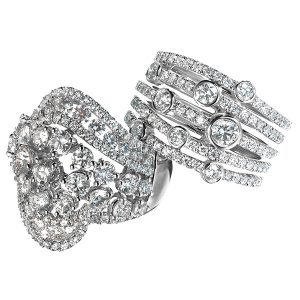Seven Upcoming Changes in the Lab-Grown Diamond Market
By Rob Bates | November 10, 2023

"The lab-grown diamond industry will flourish only when it recognizes it’s a different business from natural diamonds, Vinit Jogani, director of consulting and technology firm Lemon Consultech, said during a webinar on “Understanding the State of LGD Industry Using Data.”
“Most of the efforts today for selling lab-grown diamonds are focused on the same arguments and applications as selling natural diamonds,” Jogani said. “That is detrimental for both industries, including the lab-grown industry in the long run.
“People will need to realize that [there’s] a completely different mentality we need to bring to the table. It requires a paradigm shift.… Lab-grown diamonds cater to a different audience, and are creating new demand among people who never could have afforded a natural diamond.”
The webinar charted seven main changes that will take place in the lab-grown industry:
Smaller margins
“In the past, retailers were able to mark up [lab-grown diamonds] six times as much,” said Jogani. “In the long run this is not going to [continue], especially as lab-grown diamonds find their way into the Costcos and Walmarts, and as online retailers pose further price competition.
Eventually, he said, “retailers will have to sell three to four many times as many [lab-grown] units to maintain a similar income [as natural diamonds]. In the long run this is not sustainable for most jewelers.”
Price drops continue
“The technology keeps improving, so the cost of growing will keep going down,” said Nirav Jogani, Lemontech’s vice chairman, who also spoke on the webinar. “The main cost is in cutting and polishing and other overhead. A lot of effort is being made to develop technologies where the cutting and polishing will be robotic, and so the cutting and polishing costs will also keep going down.”
Vinit Jogani agreed that “prices are falling very quickly—10% in the last month alone. We can get a one-carat stone for well below $200 a carat.” He added that the price could decrease to $100 per carat in the future.
The lab-grown business will probably be “moving to a fixed price model, rather than a price-per-carat model,” he said. “Because a lot of the fixed costs apply to every stone.”
Declining prices have meant that fewer lab-grown diamonds are being sold with grading reports, he said. But Nirav said the price drops should be looked at as positive: “The more downstream you are, it is better that the component cost keeps going down, because then you can keep spending on marketing.
“Why does marketing not work in the natural diamond industry? Because the cost of a diamond is so high, it doesn’t leave room for that extra cost.”
Targeting market segments
“Only the top 2% of the population buys natural diamonds,” said Vinit Jogani. “Lab-grown diamonds are about the other 98%. It is much more of an accessibility story, while natural diamonds are much more of luxury story.” The two kinds of diamonds “cater to different markets, and lab-grown diamonds are expanding the overall market,” he said.
Jogani noted that $131 billion is spent on gifts of all kinds—“much larger than the bridal or even jewelry industry as a whole.”
“Why can’t lab-grown diamonds create new product segments?” he asked. “They can do things you couldn’t imagine what you could with natural diamonds. Lab-grown diamonds can open up this whole new world of possibilities—for Mother’s Day or birthdays or ‘sisters day.’ The possibilities are endless.
“There are 2 to 3 million weddings happening every year. There are maybe 85 million mothers whose children will celebrate Mother’s Day every year. That’s a much bigger market, and it’s not even competing with the natural diamond business.”
Separate grading and pricing system
“Why do we need to use the natural diamond categorization for lab-grown?” Nirav Jogani wondered. “Can’t we just have three grades for color and three grades for purity? Why do we need so many colors and so many purities? For lab-grown, there should be 10 categories max. For the consumer, for the retailer, for anyone in the pipeline downstream, a simpler categorization will be more useful, easier, less confusing, and they will have more confidence.”
He said, “In the natural diamond industry, a small difference in [a diamond’s] parameters can make a [huge difference in] value…. 1.2- and 1.3-carat stones are significantly more rare compared to 1-carat stones. There is a much wider gap in the dollar per carat.” But that’s not true in the lab-grown space, Jogani pointed out.
He predicted lab-grown diamonds will stop using the Rapaport list for pricing and move to a linear price model.
Unique stone shapes
About half of all lab-grown diamonds are rounds, according to Nirav Jogani. “Why? Because we just want to cannibalize and ride on the wings of the natural diamonds”—where 75% of stones are rounds, he said.
“We have to start thinking about creative ideas that are possible with lab-grown diamonds. People can create innumerable patents. It could be [a diamond shaped like the] alphabet, it could be stars. All these opportunities are coming up.”
Learning to coexist with naturals
“When we just try to defame and discredit the natural diamond trade in order to gain some market share, it will be counterproductive,” said Nirav. “Because then the natural diamond brands will communicate that the lab-grown diamonds are fake, they are synthetics, and don’t have value.
“So rather than fighting with each other and spoiling both business, it is better to focus on what is the new opportunity.”
Less greenwashing
Lab-grown manufacturers will find it harder to make sustainability claims ... "
https://www.jckonline.com/editorial-art ... nd-market/